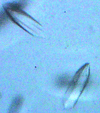issue contents
April 2017 issue

Cover illustration: An example of a structure solved using cryo-electron microscopy (Vénien-Bryan et al., p. 174).
topical reviews
Open  access
access
 access
accessSingle-particle cryo-electron microscopy (cryo-EM) has gained its `lettres de noblesse' in structural biology. The synergistic convergence of technological and computational advances now make this a feasible method for determining structures at near-atomic to atomic resolution (∼5–2 Å). The potential impact of cryo-EM on drug discovery is discussed, together with how the method can provide information on conformational variability connected to the function of macromolecular complexes.
research communications
Weak anomalous signals from serendipitously acquired surface-bound Ca atoms/native S atoms from routine data sets, that were not optimized for SAD phasing, were used to successfully phase protein structures.
The crystal structure of phosphorylated liver kinase B1 peptide in complex with 14-3-3ζ is reported.
The extracellular adhesion domain of H. pylori adhesin A was crystallized under two conditions using lithium sulfate and ammonium sulfate as the precipitant, which gave rise to two different crystal forms that diffracted to 1.95 and 2.6 Å resolution, respectively.
The X-ray crystal structure of the RNA-recognition motif of human heterogeneous ribonucleoprotein A18 is reported at 1.77 Å resolution.
PDB reference: RNA-recognition motif of hnRNP A18, 5tbx
The crystal structure of human Ca2+-bound S100A1 at 2.25 Å resolution is described.
PDB reference: S100A1, 5k89
The structure of XfsHSP17.9, a small heat-shock protein (sHSP) from X. fastidiosa, is similar to those of other sHSPs, having a conserved structural organization. The secondary structure of XfsHSP17.9 is mostly composed of β-strands and a few short α-helices. The XfsHSP17.9 structure reported here reveals a high-order architecture forming a nearly square cavity.
PDB reference: small heat-shock protein from X. fastidiosa, 5j7n
D. melanogaster enolase was purified and crystallized. It forms a homodimer with an open conformation.
PDB reference: D. melanogaster enolase, 5wro
Open  access
access
 access
accessThe growth of crystals of perdeuterated human manganese superoxide dismutase with a unit-cell edge of 240 Å was optimized for neutron data collection. Data were collected to 2.30 Å resolution from a 0.26 mm3 crystal. This is the crystal with the largest unit-cell edge from which data have been collected via neutron diffraction to sufficient resolution where hydrogen positions can be observed.
Open  access
access
 access
accessThe UAM2 protein from O. sativa was cloned, expressed, purified and crystallized, and a complete data set was obtained from the radiation-sensitive crystals by low-dose vector data collection. In addition, it is shown that UAM2 is likely to exist as a monomer in solution and contains at least one intramolecular disulfide bridge or, alternatively, a structural metal ion.


 journal menu
journal menu





















![[publBio]](/logos/publbio.gif)






